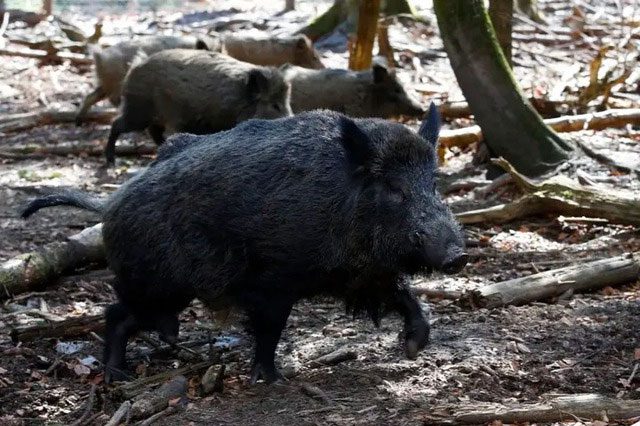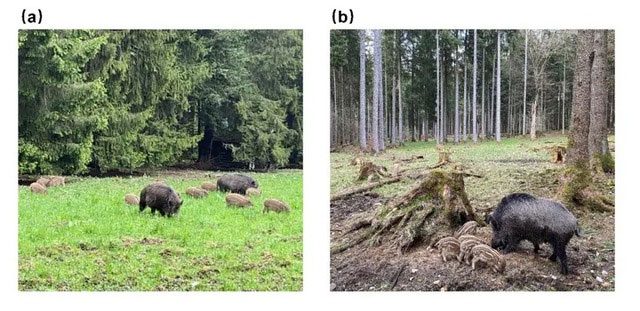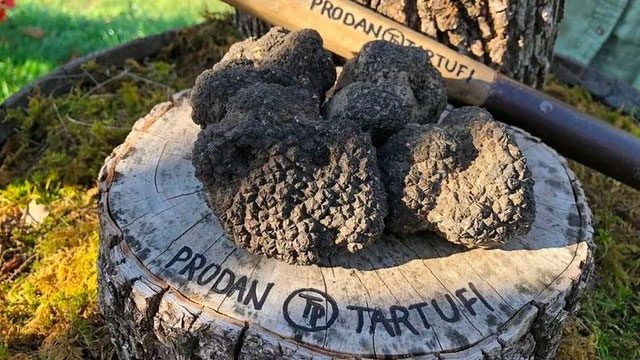According to the Berlin Environment Ministry, in 2009, hunters in Bavaria were compensated nearly €425,000 for wild boar meat that could not be sold due to radiation contamination.

A forest ranger holds a piece of wild boar meat near Munich, southern Germany, on Wednesday, August 18, 2010. (Photo: AP Photo/Matthias Schrader)
Wild boar hunted in other parts of Germany remains edible as their meat does not contain high levels of radiation. According to local regulations, if a wild boar contains more than 600 becquerels of cesium per kilogram of meat, it can only be incinerated or buried.
In Bavaria, a forest bordering the Czech Republic, the concentration of Cesium-137 in wild boars exceeds 7,000 becquerels/kg, which is about 11 times the minimum standard and completely inedible. Research indicates that the radiation absorbed from eating 1 kg of wild boar meat “is ten times the permitted limit,” equivalent to about 60% of the radiation that the human body absorbs each year under normal conditions.

To monitor the nuclear radiation levels of wild boars locally, 70 monitoring stations have been established in Bavaria, and all hunted wild boars must undergo radiation testing.
Clearly, Germany has never experienced a nuclear leak or explosion, so why are wild boars there so severely contaminated with radiation? Beginning in 2019, scientists started collecting 48 samples of wild boar meat from hunters in Bavaria and various collection areas. At each site, fresh tissue samples from the hunted wild boars are separated, frozen, and sent to the Leibniz University in Hannover after the hunt.

In the laboratory, wild boar tissue samples are thawed at room temperature and then cut into smaller pieces (less than 2 cm in diameter) while ensuring that all foreign substrates are completely removed. The samples are then dried at 110°C for 24 hours, followed by ash analysis through incineration at 420°C for a total of 36 hours and stored. Results showed that 88% of the sampled wild boar meat had cesium levels exceeding the legal limit set by German law, and 100% of the measured figures exceeded the limits established by Japan.

The ratios of Cesium-137 and Cesium-135 in wild boars from various regions of Bavaria.
Subsequently, researchers looked for isotopic signs for identification. Scientists are particularly interested in two forms of Cesium – Cesium-137 and Cesium-135. They can determine whether cesium originates from a reactor or a nuclear explosion based on the ratios of these two produced substances.
Scientists found that all wild boar meat contains cesium from the Chernobyl nuclear accident as well as radioactive cesium from nuclear fallout. The proportion of contamination from nuclear fallout varies among different samples, ranging from 10% to 99%. In other words, in a quarter of the sampled wild boar meat, the radiation solely from nuclear fallout is sufficient to render the meat dangerous and inedible.

The Chernobyl power plant is about 1,300 km from Bavaria; after the nuclear reactor explosion in 1986, radioactive dust spread into the environment, contaminating wild animals in Bavaria and elsewhere with cesium.
During the Cold War, among more than 2,000 nuclear bombs detonated worldwide, 500 were exploded in the atmosphere, releasing a vast amount of radioactive material and creating a significant quantity of radioactive dust that spread around the globe due to wind patterns, rainfall, and sedimentation. These particles are now virtually everywhere in the soil, but they have generally decayed. Some radioactive nuclei, such as Cesium-137 and Strontium-90, have long half-lives and can persist in the environment for decades or even centuries, causing long-term contamination.
Due to rainfall, these radioactive substances are introduced into the soil. In forests, certain types of mushrooms (such as straw mushrooms and black truffles) absorb water and nutrients from the soil through mycelium while also taking up radioactive nuclei from the ground such as Uranium, Plutonium, Cesium, Strontium, etc. These nuclei can exist in the soil longer in agricultural areas, especially in regions like high-altitude pastures, forests, and plateaus.

Bavarian wild boars have few other food sources besides mushrooms and black truffles.
Mushrooms have unique metabolic capabilities that allow them to utilize radioactive nuclei as an energy source. For example, some types of mushrooms can decompose radioactive graphite from nuclear reactors or use melanin to absorb radiation and convert it into energy, similar to how plants use chlorophyll to convert sunlight into energy through photosynthesis. These types of mushrooms grow faster under radiation and are more likely to accumulate radioactive substances.
As a result, organisms like mushrooms have high bioaccumulation factors (BCF). This refers to the ratio of the concentration of a specific substance in an organism to the concentration of that substance in the environment. Generally, the higher the BCF, the easier it is for the organism to absorb and enrich the substance from the environment. The BCF of mushrooms can reach hundreds or even thousands, which is significantly higher than that of other plant and animal species. In winter, Bavarian wild boars have few other food sources besides mushrooms and black truffles, making them particularly vulnerable to the effects of nuclear radiation. This is why the radiation levels in most animal species decreased several years after the Chernobyl accident, but this did not happen with Bavarian wild boars.

Wild boars may have completed their reproductive cycle and died naturally before radiation-related diseases appeared.
Moreover, black truffles are very hard to find in nature. However, wild boars can smell black truffles through their sensitive noses. When wild boars eat radioactive mushrooms, they do not transform into monsters, but they still have a certain impact on the environment and humans. Wild boars reproduce extremely quickly, and the number of these radioactive wild boars can spiral out of control as no one wants to consume them, hunters may be unwilling to kill them, and government subsidies are also limited. This way, wild boars can cause significant damage to forest vegetation and nearby farms.
So the question arises: why do wild boars continue to thrive despite being contaminated with nuclear radiation? Because the lifespan of wild boars is relatively short, usually only 4 to 5 years, and the damage caused by nuclear radiation to organisms often takes many years or even decades to manifest. Therefore, wild boars may have completed their reproductive cycle and died naturally before radiation-related diseases emerged, allowing them to maintain population stability.
Additionally, wild boars possess certain resistance, resilience, and the ability to adapt to high-radiation environments. Some studies have found that wild boars exposed to low-dose radiation in Fukushima for extended periods do not show biological signs of stress and DNA damage, such as shortened telomeres and elevated cortisol levels, indicating their overall health is not significantly affected.


















































